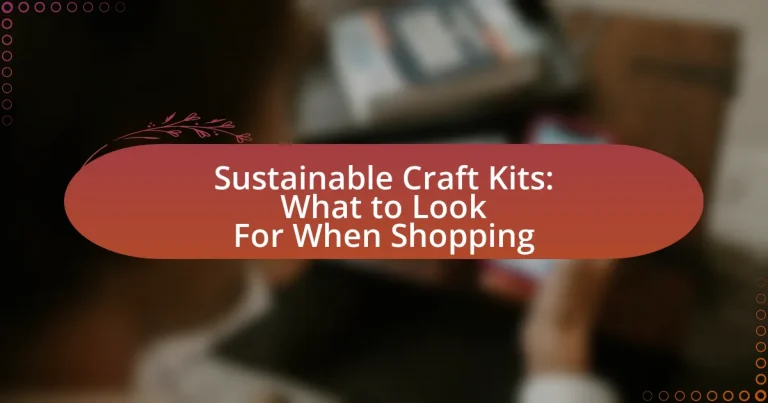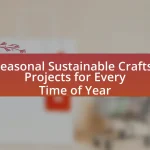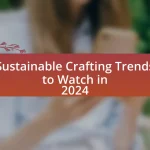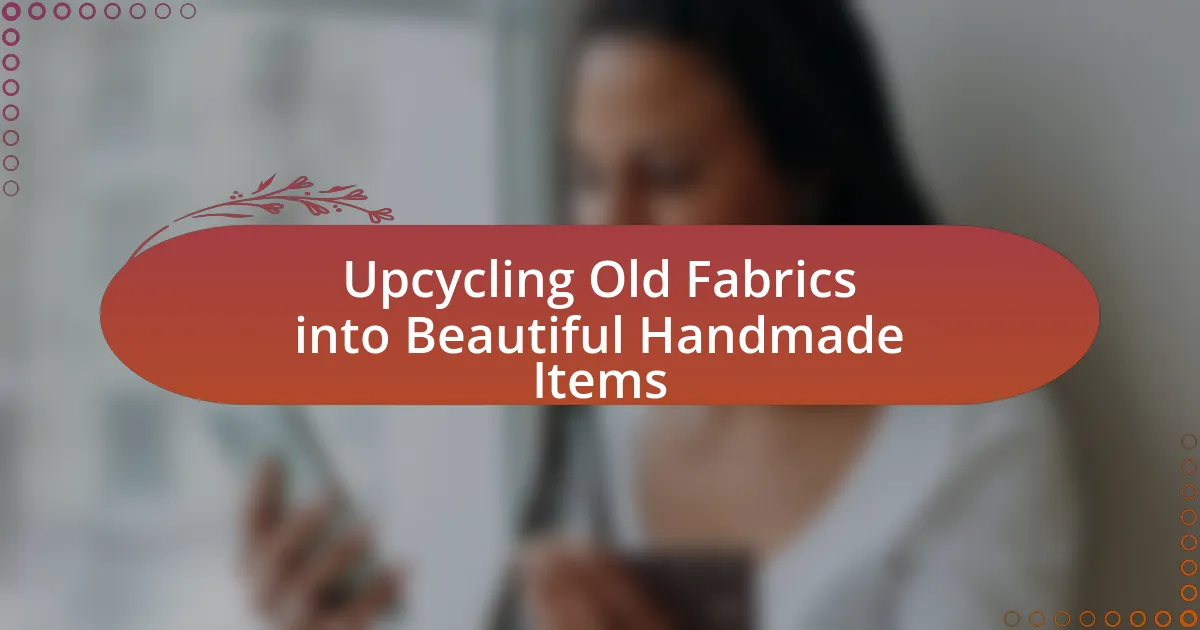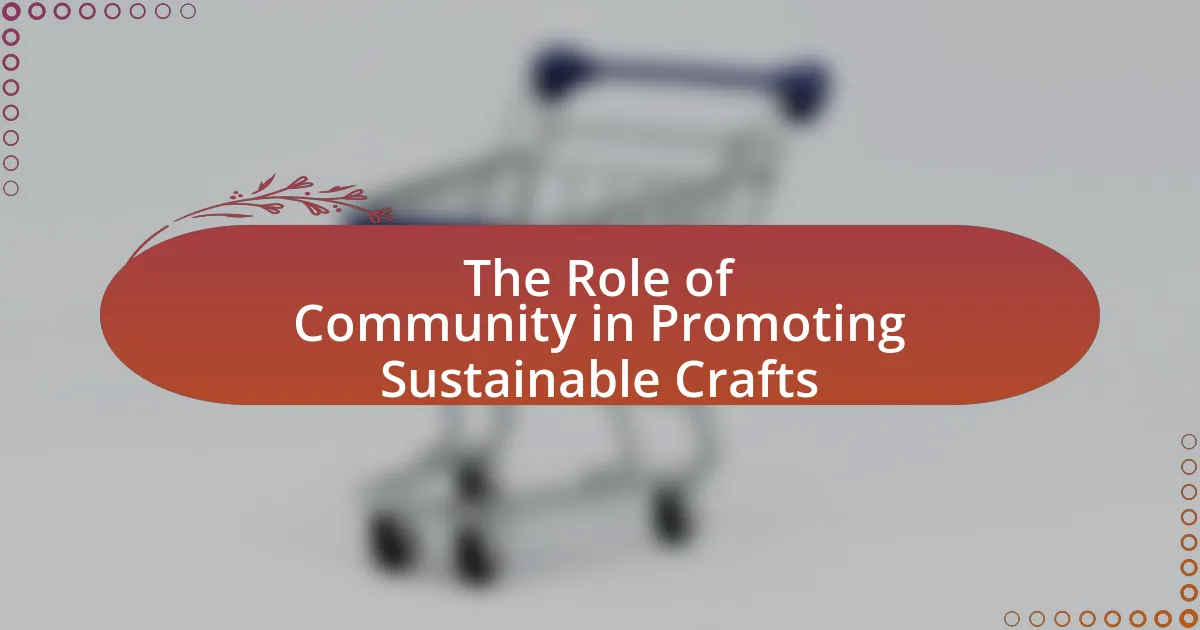Sustainable craft kits are DIY project sets made from environmentally friendly materials, such as recycled paper, organic cotton, and biodegradable components, aimed at promoting eco-conscious crafting practices. This article outlines the differences between sustainable and traditional craft kits, highlighting the importance of using eco-friendly materials and certifications like FSC and GOTS. It discusses the benefits of sustainable crafting, including reduced environmental impact, support for local communities, and enhanced creativity. Additionally, the article provides practical tips for selecting, using, and maximizing the effectiveness of sustainable craft kits while minimizing waste and promoting responsible purchasing decisions.

What are Sustainable Craft Kits?
Sustainable craft kits are DIY project sets designed with environmentally friendly materials and practices in mind. These kits typically include supplies made from recycled, organic, or non-toxic materials, promoting sustainability in crafting. For example, many sustainable craft kits utilize biodegradable packaging and aim to minimize waste, aligning with eco-conscious consumer values. The growing demand for such products reflects a broader trend towards sustainability in the crafting community, as consumers increasingly seek to reduce their environmental impact while engaging in creative activities.
How do Sustainable Craft Kits differ from traditional craft kits?
Sustainable craft kits differ from traditional craft kits primarily in their materials and environmental impact. Sustainable craft kits utilize eco-friendly, biodegradable, or recycled materials, reducing waste and promoting sustainability, while traditional craft kits often contain plastic or non-recyclable components that contribute to environmental pollution. For example, a study by the Ellen MacArthur Foundation highlights that plastic production and waste significantly harm ecosystems, emphasizing the importance of using sustainable materials in crafting.
What materials are commonly used in Sustainable Craft Kits?
Sustainable Craft Kits commonly use materials such as recycled paper, organic cotton, bamboo, and non-toxic adhesives. These materials are chosen for their minimal environmental impact and renewable nature. For instance, recycled paper reduces waste and conserves resources, while organic cotton is grown without harmful pesticides, promoting healthier ecosystems. Bamboo is a fast-growing plant that requires less water and no fertilizers, making it an eco-friendly choice. Non-toxic adhesives ensure safety for users and the environment, aligning with the principles of sustainability.
Why is sustainability important in crafting?
Sustainability is important in crafting because it minimizes environmental impact and promotes the responsible use of resources. Sustainable crafting practices, such as using eco-friendly materials and reducing waste, help preserve natural ecosystems and reduce pollution. For instance, the use of recycled or biodegradable materials in craft kits can significantly lower the carbon footprint associated with production and disposal. According to a study by the Ellen MacArthur Foundation, transitioning to a circular economy, which includes sustainable crafting, could generate $4.5 trillion in economic benefits by 2030. This demonstrates that sustainability not only supports environmental health but also contributes to economic growth.
What are the key features to look for in Sustainable Craft Kits?
Key features to look for in Sustainable Craft Kits include eco-friendly materials, non-toxic supplies, and minimal packaging. Eco-friendly materials, such as recycled paper or organic cotton, ensure that the kit is produced with a lower environmental impact. Non-toxic supplies, including safe adhesives and paints, protect both the user and the environment. Minimal packaging reduces waste, aligning with sustainability goals. These features collectively contribute to a more responsible crafting experience, supporting environmental conservation and health.
How can you identify eco-friendly materials in craft kits?
To identify eco-friendly materials in craft kits, look for certifications such as FSC (Forest Stewardship Council) for wood products, and labels indicating organic or recycled content. These certifications ensure that materials are sourced sustainably and have minimal environmental impact. Additionally, check for non-toxic and biodegradable components, as these are indicators of eco-friendliness. Research shows that products labeled with these certifications often meet strict environmental standards, making them a reliable choice for sustainable crafting.
What certifications should you look for when shopping for Sustainable Craft Kits?
When shopping for Sustainable Craft Kits, look for certifications such as the Forest Stewardship Council (FSC) certification, which ensures that wood and paper products come from responsibly managed forests. Additionally, the Global Organic Textile Standard (GOTS) certification indicates that textiles are made from organic fibers and meet environmental and social criteria. The Cradle to Cradle certification assesses the safety and sustainability of materials used in products. These certifications provide assurance that the craft kits are produced with environmentally friendly practices and materials, supporting sustainability in crafting.
What benefits do Sustainable Craft Kits offer to consumers?
Sustainable Craft Kits offer consumers environmental benefits, educational value, and enhanced creativity. These kits utilize eco-friendly materials, reducing waste and promoting sustainable practices. For instance, many kits are made from recycled or biodegradable components, which help minimize the carbon footprint associated with traditional crafting supplies. Additionally, they often include instructions that encourage skill development and creativity, allowing consumers to engage in hands-on learning experiences. Research indicates that engaging in creative activities can improve mental well-being and reduce stress, further enhancing the appeal of these kits.
How do Sustainable Craft Kits contribute to environmental conservation?
Sustainable craft kits contribute to environmental conservation by utilizing eco-friendly materials and promoting waste reduction. These kits often include biodegradable or recycled components, which minimize the environmental impact associated with traditional crafting supplies. For instance, a study by the Environmental Protection Agency indicates that using recycled materials can significantly reduce landfill waste, thereby conserving natural resources. Additionally, sustainable craft kits encourage individuals to engage in creative activities that repurpose materials, fostering a culture of sustainability and awareness about environmental issues.
What impact do Sustainable Craft Kits have on local communities?
Sustainable Craft Kits positively impact local communities by promoting economic growth and fostering social connections. These kits often utilize locally sourced materials, which supports local artisans and businesses, thereby enhancing the local economy. For instance, a study by the Craft Industry Alliance found that craft-related activities can generate significant income for small businesses, contributing to community resilience. Additionally, Sustainable Craft Kits encourage collaboration and creativity among community members, leading to stronger social ties and a sense of belonging. This engagement can result in community events and workshops that further enhance local culture and cohesion.
How can you ensure you are making a responsible purchase?
To ensure you are making a responsible purchase, evaluate the sustainability and ethical practices of the product and its manufacturer. Responsible purchases involve selecting items made from eco-friendly materials, such as organic cotton or recycled plastics, which minimize environmental impact. Additionally, verify that the manufacturer adheres to fair labor practices, ensuring workers are treated ethically and compensated fairly. Researching certifications, such as Fair Trade or Global Organic Textile Standard, can provide assurance of these practices. According to a 2021 study by the Ellen MacArthur Foundation, sustainable products can significantly reduce waste and carbon emissions, reinforcing the importance of making informed purchasing decisions.
What are some common misconceptions about Sustainable Craft Kits?
Common misconceptions about Sustainable Craft Kits include the belief that they are always more expensive than traditional kits, that they lack quality or variety, and that all materials are entirely biodegradable or eco-friendly. In reality, while some sustainable kits may have a higher upfront cost due to ethically sourced materials, many are competitively priced. Additionally, sustainable craft kits often offer a wide range of high-quality options, incorporating diverse materials and techniques. Furthermore, not all sustainable kits guarantee complete biodegradability; some may use recycled materials that are durable but not fully compostable.
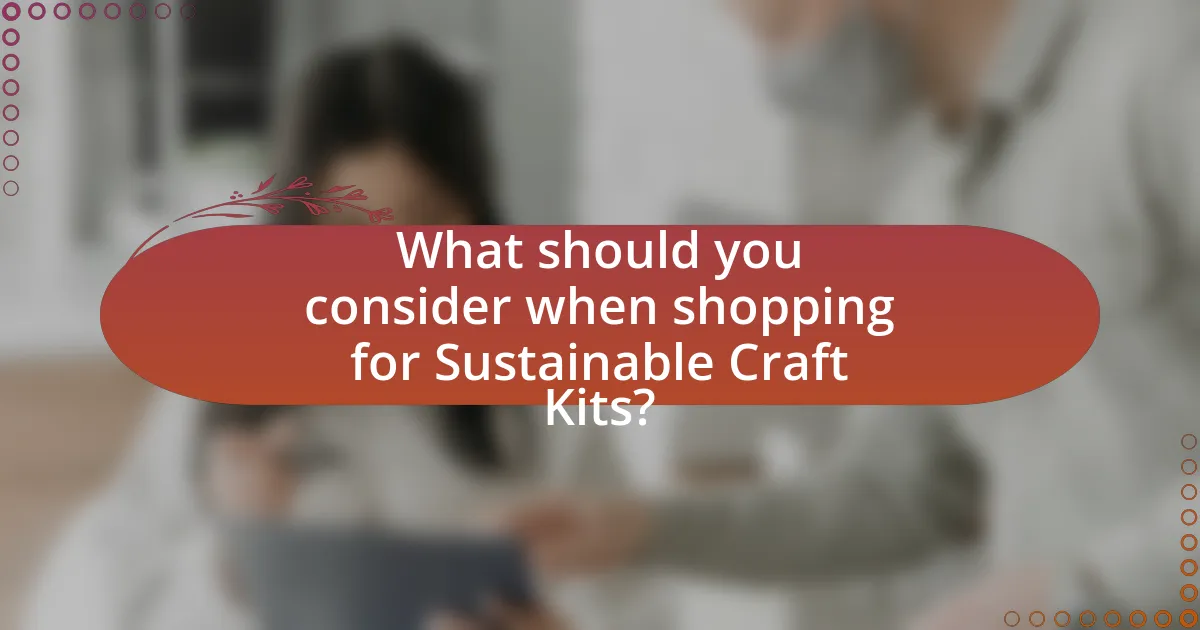
What should you consider when shopping for Sustainable Craft Kits?
When shopping for Sustainable Craft Kits, consider the materials used in the kit, ensuring they are eco-friendly and sourced sustainably. Sustainable craft kits typically utilize organic, recycled, or biodegradable materials, which minimize environmental impact. Additionally, evaluate the packaging to confirm it is recyclable or compostable, as this further supports sustainability efforts. Look for certifications or labels that indicate ethical sourcing or environmental responsibility, such as Fair Trade or FSC certification. These factors collectively ensure that the craft kit aligns with sustainable practices and contributes positively to the environment.
How do you assess the quality of a Sustainable Craft Kit?
To assess the quality of a Sustainable Craft Kit, evaluate the materials used, the environmental impact, and the instructions provided. High-quality kits utilize eco-friendly, non-toxic materials such as recycled paper, organic fabrics, or sustainably sourced wood, which contribute to reduced environmental harm. Additionally, the kit should come with clear, comprehensive instructions that facilitate the crafting process, ensuring that users can successfully complete the projects. Research indicates that products labeled as sustainable often meet specific environmental standards, such as those set by organizations like the Forest Stewardship Council or the Global Organic Textile Standard, which further validates their quality.
What indicators suggest a high-quality Sustainable Craft Kit?
High-quality Sustainable Craft Kits are indicated by the use of eco-friendly materials, clear sourcing information, and positive customer reviews. Eco-friendly materials, such as organic cotton, recycled paper, or non-toxic paints, ensure that the kit minimizes environmental impact. Clear sourcing information, including certifications like Fair Trade or FSC (Forest Stewardship Council), demonstrates ethical production practices. Positive customer reviews often highlight the kit’s usability, durability, and overall satisfaction, providing insight into the quality and effectiveness of the craft kit.
How can you evaluate the longevity of the materials used?
To evaluate the longevity of the materials used in sustainable craft kits, one should assess their durability, resistance to wear, and environmental stability. Materials such as bamboo, recycled plastics, and organic cotton are known for their long-lasting properties; for instance, bamboo can withstand moisture and is less prone to warping compared to other woods. Additionally, examining certifications like the Global Organic Textile Standard (GOTS) for textiles or the Forest Stewardship Council (FSC) for wood can provide assurance of material quality and sustainability. Research indicates that products made from these certified materials tend to have a longer lifespan, reducing the need for frequent replacements and contributing to sustainability.
What price range should you expect for Sustainable Craft Kits?
Sustainable Craft Kits typically range in price from $15 to $60. This price variation is influenced by factors such as the complexity of the kit, the quality of materials used, and the brand reputation. For instance, basic kits aimed at beginners may be priced around $15 to $30, while more advanced kits that include premium materials or specialized tools can reach $50 to $60.
How does the price of Sustainable Craft Kits compare to traditional kits?
Sustainable Craft Kits generally have a higher price point compared to traditional kits. This price difference is primarily due to the use of eco-friendly materials and ethical sourcing practices, which often incur greater production costs. For instance, a study by the Journal of Cleaner Production found that sustainable products can be up to 20% more expensive than their conventional counterparts due to these factors.
What factors influence the pricing of Sustainable Craft Kits?
The pricing of Sustainable Craft Kits is influenced by several key factors, including the quality of materials used, production methods, and brand reputation. High-quality, eco-friendly materials such as organic cotton or recycled paper typically increase costs due to their sourcing and processing. Additionally, sustainable production methods, which often involve ethical labor practices and lower environmental impact, can also raise prices. Brand reputation plays a significant role, as established brands with a commitment to sustainability may charge a premium for their products, reflecting consumer trust and perceived value.
Where can you find reliable sources for purchasing Sustainable Craft Kits?
Reliable sources for purchasing Sustainable Craft Kits include specialized online retailers such as Eco Warrior, Green Kid Crafts, and Etsy. These platforms are known for their commitment to sustainability and offer a variety of eco-friendly craft kits made from non-toxic materials. Eco Warrior focuses on environmentally responsible products, while Green Kid Crafts emphasizes educational and sustainable crafting experiences. Etsy features numerous independent sellers who prioritize sustainable practices in their offerings.
What online platforms specialize in Sustainable Craft Kits?
Etsy, Amazon, and Craftsy are online platforms that specialize in Sustainable Craft Kits. Etsy features a wide range of handmade and eco-friendly craft supplies, allowing artisans to sell sustainable kits directly to consumers. Amazon offers a selection of sustainable craft kits from various sellers, often highlighting products made from recycled or organic materials. Craftsy focuses on crafting education and provides kits that emphasize sustainable practices and materials. These platforms collectively support the growing demand for environmentally friendly crafting options.
How can local stores support your search for Sustainable Craft Kits?
Local stores can support your search for Sustainable Craft Kits by offering a curated selection of eco-friendly materials and products. These stores often prioritize sourcing from local artisans and manufacturers who use sustainable practices, ensuring that the kits are made from renewable resources and non-toxic materials. Additionally, local stores can provide knowledgeable staff who can guide customers in selecting kits that align with their sustainability goals, enhancing the shopping experience. Research indicates that consumers are increasingly seeking sustainable options, with a 2021 survey by Nielsen showing that 73% of global consumers would change their consumption habits to reduce environmental impact. This trend encourages local stores to stock sustainable craft kits, thereby meeting customer demand while promoting environmentally responsible crafting.
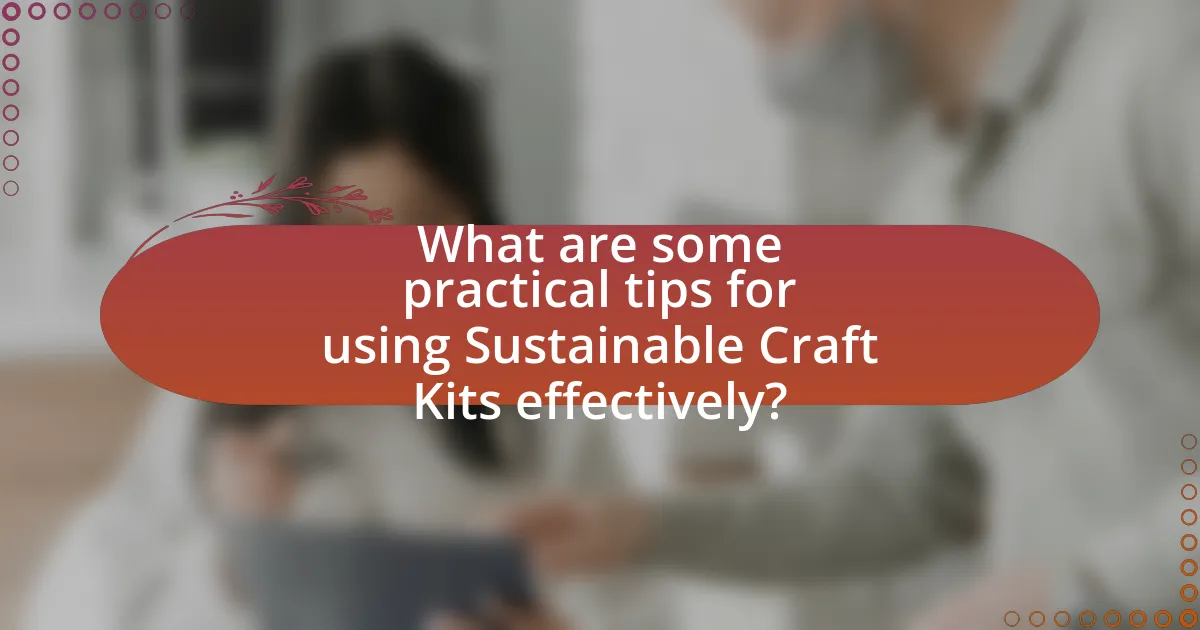
What are some practical tips for using Sustainable Craft Kits effectively?
To use Sustainable Craft Kits effectively, first, select kits that include eco-friendly materials, ensuring that the components are biodegradable or recyclable. This choice minimizes environmental impact and supports sustainability. Next, follow the instructions carefully to maximize the use of materials and reduce waste; many kits are designed to minimize excess. Additionally, engage in creative repurposing of leftover materials from the kits, which can lead to innovative projects and further reduce waste. Lastly, consider collaborating with others to share resources and ideas, enhancing the crafting experience while promoting community engagement and sustainability.
How can you maximize the use of materials in Sustainable Craft Kits?
To maximize the use of materials in Sustainable Craft Kits, prioritize kits that include multi-functional components and instructions for various projects. This approach allows users to create multiple items from the same set of materials, reducing waste and encouraging creativity. For instance, a kit that provides fabric scraps can be used for sewing, patchwork, or even as stuffing for plush toys, thereby extending the utility of each material. Additionally, selecting kits that emphasize recyclable or biodegradable materials ensures that any leftover components can be disposed of responsibly, further enhancing sustainability.
What are some creative ways to repurpose leftover materials?
Repurposing leftover materials can be achieved through various creative methods. For instance, fabric scraps can be transformed into patchwork quilts or reusable shopping bags, effectively reducing waste while creating functional items. Additionally, glass jars can serve as storage containers or decorative vases, enhancing home organization and aesthetics. Cardboard boxes can be converted into organizers or playhouses for children, promoting imaginative play. These methods not only minimize waste but also encourage resourcefulness and creativity in crafting.
How can you involve others in your crafting projects sustainably?
To involve others in your crafting projects sustainably, you can organize community crafting events that utilize eco-friendly materials and promote the use of recycled items. By sourcing sustainable craft kits that emphasize biodegradable or upcycled components, participants can engage in projects that minimize environmental impact. Research shows that community involvement in crafting not only fosters creativity but also raises awareness about sustainability practices, as highlighted in studies by the Craft and Hobby Association, which indicate that collaborative crafting can lead to increased interest in sustainable living.
What are the best practices for maintaining sustainability while crafting?
The best practices for maintaining sustainability while crafting include using eco-friendly materials, minimizing waste, and supporting local artisans. Eco-friendly materials, such as organic cotton, bamboo, or recycled paper, reduce environmental impact and promote sustainable sourcing. Minimizing waste can be achieved by planning projects carefully to use materials efficiently and repurposing scraps for new creations. Supporting local artisans fosters community economies and reduces carbon footprints associated with transportation. According to a study by the Ellen MacArthur Foundation, transitioning to sustainable materials can significantly decrease the environmental impact of crafting activities.
How can you minimize waste during your crafting process?
To minimize waste during your crafting process, plan your projects carefully and use precise measurements. By creating a detailed list of materials needed and calculating the exact amounts, you can significantly reduce excess materials. Additionally, repurpose leftover scraps into new projects or components, which not only minimizes waste but also encourages creativity. Studies show that up to 30% of crafting materials can go unused, so implementing these strategies can lead to more sustainable practices in crafting.
What are some eco-friendly tools and supplies to consider?
Eco-friendly tools and supplies to consider include biodegradable glues, recycled paper, and natural fiber brushes. Biodegradable glues, such as those made from plant-based materials, reduce environmental impact compared to traditional adhesives. Recycled paper, sourced from post-consumer waste, minimizes deforestation and energy consumption during production. Natural fiber brushes, made from materials like bamboo or hemp, are sustainable alternatives to synthetic brushes, which often contribute to plastic pollution. These options not only support eco-friendly practices but also enhance the sustainability of craft projects.
